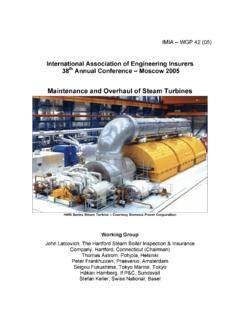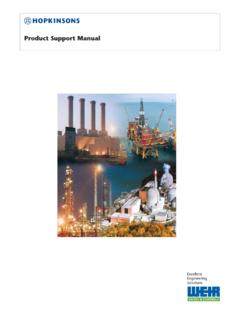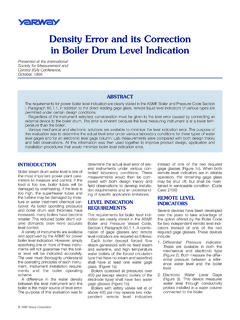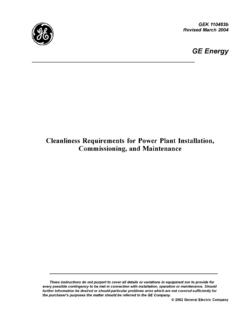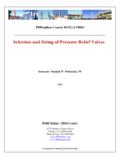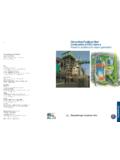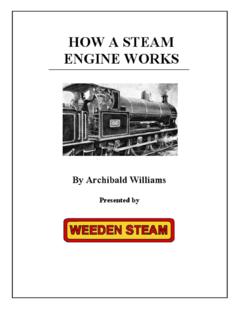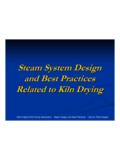Transcription of TOSHIBA Turbine - Steam Turbine, Steam Boiler, …
1 TOSHIBA Turbine and Auxiliaries CONTENTS Steam Turbines for Central Power Stations .. 2 Kinds and types .. 2 Performance .. 4 Structure .. 5 Structure of each Turbine 10 Control device .. 12 Safety device .. 15 Lubricating device .. 18 Steam Turbine Auxiliary 19 Condensing equipment .. 19 Feed-water heaters and deaerators .. 21 Controls for auxiliary 23 Steam TURBINES FOR CENTRAL POWER STATIONSSCSF type: single-casing, single-flow exhaust type TCSF type: tandem-compound, single-flow exhaust type TCDF type: tandem-compound, double-flow exhaust type TCTF type: tandem-compound, triple-flow exhaust type TC4F type: tandem-compound, four-flow exhaust type CCSF type: cross-compound, single-flow exhaust type CCDF type: cross-compound, double-flow exhaust type CC4F type: cross-compound, 4-flow exhaust type CC6F type.
2 Cross-compound, 6-flow exhaust type sometimes fixed at 3,600 or 3,000 , its high-pressure side may be made into a compactly constructed andhighly efficient rotary machine operating at3,600 or 3,000 rpm, and its low-pressure side may be made into a rotary machineequipped with large blades suitable forpassing large quantities of low-pressure Steam with high efficiency and operating at1,800 or 1,500 rpm. Steam turbines fornuclear power generation are generallylarge-capacity rotary machines operating at1,500 rpm. The construction of the exhaustchamber is divided as to the effective length of the last-stage blades, the quantity of Steam and so on into single-flow (SF), double-flow (DF), triple-flow (TF), four-flow (4F), and six-flow (6F) types. If they further increase in size, a division of Steam floweven more numerous is conceivable.
3 By combining the above divisions of steamflow and the arrangement types of the high,intermediate- and low-pressure turbines, Steam turbines for central power stationsare produced in the following types: Steam turbines for central power stationsmay be broadly divided as to the kind ofsteam source into three types: steamturbines for thermal power generation, Steam turbines for nuclear powergeneration, and Steam turbines forgeothermal power generation. Steamturbines for thermal power generation are further divisible into a non-reheating type (which requires comparatively simplefacilities) and a reheating type (which ishighly efficient but requires somewhatcomplex facilities). Although designed forindoor application, they may be usedoutdoors by providing an appropriatehousing. Steam turbines for central power stations are divided as to the pressure and temperature of the Steam they use, their output and so on into high, intermediate, and low-pressure turbines.
4 These turbines are arranged in a single row in the tandem type (TC type) and in two rows in the cross-compound type (CC type). In the cross-compound type, the speed of each Turbine shaft is type, and so on. Maximum outputcapacities per unit so far attained areas follows- in Steam turbines for thermal power generation-150,OOOkW for non-reheating type, 700,OOOkW for tandem reheatingtype, and 1,000,OOOkW for cross reheating type; 1,100,OOOkW forsteam turbines for nuclear powergeneration; and 114,OOOkW for steamturbines for geothermal powergeneration. TOSHIBA started construction ofsteam turbines for use in centralpower stations in the early 1930's. During the 45 years since then, it hasproduced about 140 units (includingthose presently in production) ofnew-type efficient Steam turbines withsteam pressure of over 60kg/cm2,whose total output capacity hasalready reached 42,500,OOOkW.
5 These units include nearly all machines thathave established excellent records inrespect to output capacity, Kinds and typesFig. 1 600MW Tandem, 6-Flow-type Steam Turbine Fig. 2 600MW Cross, 4-Flow-type Steam Turbine 3In view of the trend to provide supercritical pressure and higher-temperature Steam to beemployed in the future, and to increase the capacity of single units, TOSHIBA stands ready to meet customer demands for any type of high-efficiency, large-capacity Steam Turbine for use incentral power stations, supported by its advanced manufacturing technology and its innovative production facilities. Regarding a reheating Turbine , its thermalefficiency is influenced by the reheatingpressure, reheating temperature, andnumber of reheating stages in addition tothe above conditions. For example, in thecase of the standard, single-stage reheating cycle as shown in Fig.
6 4,variations in the net thermal efficiencyagainst variations in the main steampressure when the conditions listed beloware assumed are as shown in that Degree of vacuum of exhaustchamber: 722mmHg b. Reheater inlet pressure: main steampressure x c. Feed-water temperature: as shown inFig. 5 d. Sum of Steam pressure drops inreheating Steam pipe and reheater:10%The blade and nozzle of each turbinestage has a shape finely wrought from theviewpoint of fluid mechanics and isconstructed to minimize the steamleakage from various Turbine parts inorder to improve mechanical the same time, by taking account of thefeed-water temperature, pressure ofextracted Steam , reheating pressure, typeand arrangement of the feed-water heaterand so on which are best suited for thepower plant under consideration,completion of a highly efficient turbineplant is always the prime objective.
7 Thermal efficiency of the non-reheatingturbine cycle is governed mainly byconditions of the Steam used, such as themain Steam pressure, main steamtemperature, exhaust pressure, numberof extraction stages, feed-watertemperature, efficiency of the boilerfeed-water pump, and thermal efficiencyof the Turbine cycle in the case of astandard cycle. The net thermal efficiencyof a plant when its output is 100MW islisted in Table 2. Turbine type-output ( MW) Speed (rpm) Blade lengths (inch) Annuals area/SF (ft ) SF DF TF 4F 6F 20 35-53 70-105105-160 140-210210-320 23 47-70 95-140140-210 190-280280-420 26 59-87 118-175175-260 235-350350-520 30 80-118 160-235240-350 320-470480-700 3600 95-140 190-280280-420 380-470480-700 20 37-56 75-115110-170 150-225220-340 23 52-77
8 105-155155-230 210-310310-460 26 74-109 150-220220-330 295-440440-655 3000 72 104-153 210-310310-460 415-615625-920 35 120-177 240-355360-530 480-710720-106038 135-200 270-400410-600 540-800820-120038 150-220 330-440450-660 600-890900-133042 175-260 350-520530-780 705-10401060-15601800 52 245-360 490-725740-1090 980-14501480-217035 120-177 240-355360-530 480-710720-106041 165-245 330-490490-740 660-980990-14701500 52 245-360 490-725740-1090 980-14501480-2170 The relationship between theturbine type (in which the turbineexhaust flow is combined with thestandard blade length of the laststage) and the approximatestandard output is listed in Table1.
9 Table 1 Turbine Type and Output Performance e. Enthalpy rise of feed-water in each feed-water heater is assumed to be equal. f. Discharge pressure of boiler feed-water pump: times the main Steam pressure g. Efficiency of boiler feed-water pump: 70% h. Power of auxiliaries for boiler feed-water pump: of generator output power i. Efficiency of boiler: 89% The net thermal efficiency of a plant alsovaries according to the Turbine type inaddition to the above Steam conditions. Anexample of this variation is shown in Fig. 6. Numerals at the end of the Turbine namesshown on the curves indicate the effectivelength (in inches) of the last stage bladeTable 2 Thermal Efficiency of Nonreheating Tu r b in e (when out put is 100MW)Stream pressure (kg/cm g) Stream temperature ( C) Turbine thermal efficiency (%)Net efficiency of plant (%) 60 68 102 127 485 510 538 566 Fig.
10 3 Basic cycle Fig. 5 Feed-water temperature of Basic Cycle Fig. 4 Net Thermal Efficiency of Basic Cycle Fig. 6 Types of Turbines and Net Thermal Efficiency Netthermal efficiency of Plant( %) 4 Reheating Turbine As examples of structures of thenonreheating-type turbines, Fig. 7 is adiagram of an SCSF-type 66MW turbineand Fig. 8 is a TCDF-type 150MW Turbine . In the former (Fig. 7), thehigh-pressure part and the low-pressure part of the Turbine casing are fastenedtogether by bolted vertical joint into asingle casing. The rotor is a solid rotorproduced by machining a single forgingand is supported by two bearing units. The overall length is shorter than that upthe TCDF-type (whose cross section isshown below), rendering the entireturbine shape compact. In the latter ( ), the casing is divided into two parts-a high-pressure parts and a low-pressure part.
